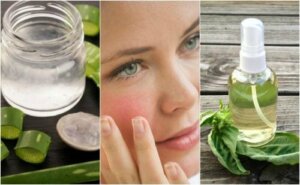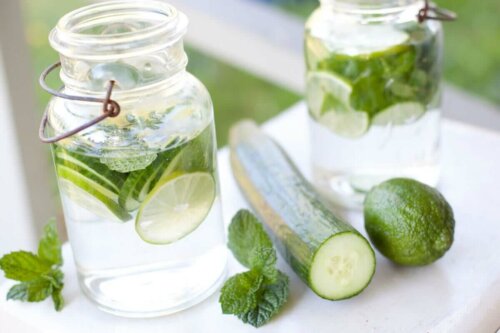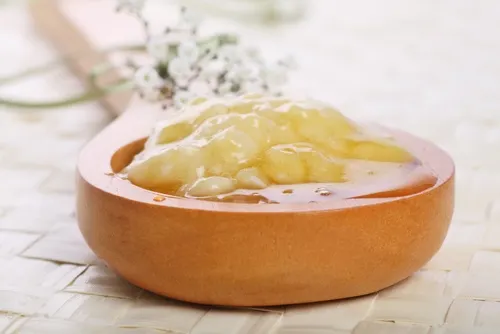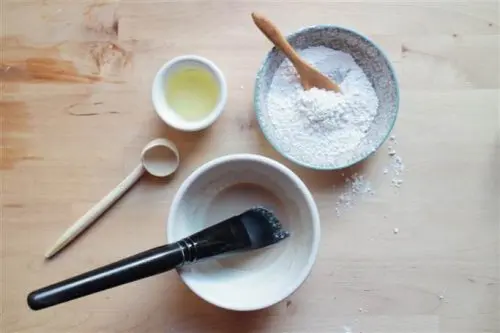The Top 5 Home Remedies to Soothe Irritated Skin


Reviewed and approved by the doctor Karla Henríquez
We’ve all had irritated skin at one time or another. Our skin is continuously exposed to aggressive agents. The sun, environmental toxins, and chemicals in some cosmetics are only a small part of the factors that can cause allergic reactions or irritation.
As a result, uncomfortable symptoms such as itching and redness may occur, as well as an accumulation of dead skin cells, dryness, and other discomforts that affect both the health and appearance of the skin.
There’s a wide variety of conventional products to counteract most skin issues, but sometimes they’re expensive or contain substances that cause unwanted side reactions. Fortunately, there are 100% natural remedies that help soothe irritated skin effectively and safely. Learn all about them here!
Irritated skin: Causes and symptoms
Irritated skin feels irritated on the inside and looks irritated on the outside. Thus, some of the symptoms that manifest themselves can easily be noticed, such as redness or dryness.
Others, such as burning or itching, on the other hand, can be felt by the person. However, both types of symptoms affect a person’s quality of life.
Overall, there are several reasons why the skin becomes irritated. Some may have to do with a disease, others with external factors, and even a combination can occur. Among the most common causes of irritated skin we have:
- Xerosis
- Atopic dermatitis
- Excessive sun exposure
- Allergic reactions
- Exposure to irritants: detergents, cosmetics, etc.
- Aesthetic treatments
Home remedies to soothe irritated skin
Here are some remedies to soothe irritated skin. They’re effective, simple to prepare, and the ingredients are easy to find at home or can be purchased easily. Try them. You’ll be surprised by how much they can help!
1. Cucumber and rose water remedy

The mixture of cucumber and rosewater provides a moisturizing tonic with firming and anti-inflammatory properties that reduce irritation and itching after being assimilated into the skin.
It contains vitamins, minerals, and antioxidant compounds that act on cells to promote regeneration.
Ingredients
- One cucumber
- ½ cup rose water (125 ml)
Preparation
- Peel the cucumber and pour it into the blender with the rose water.
- Then, blend the ingredients until smooth.
How to apply it
- Spread the treatment over the areas of skin you wish to soothe, and leave on for 30 minutes.
- Rinse and store the remaining mixture in the refrigerator.
- Repeat daily until your skin health is improved.
You might find this interesting: Orange Blossom Water – A Natural Remedy for Skin Care
2. Green tea for irritated skin
The antioxidants in green tea are useful for accelerating the recovery of the skin in cases of aggression from the sun or toxins. Its active ingredients stimulate tissue repair and can even stop some allergic reactions that cause irritation.
Ingredients
- Two tablespoons green tea (20 g)
- 1 cup water (250 ml)
Preparation
- Bring a cup of water to a boil. When it comes to a boil, add the tablespoons of green tea.
- Let the drink steep at room temperature. Then, chill it for a couple of hours in the refrigerator.
- When it’s well chilled, strain it and proceed to use it.
How to apply it
- Spray the drink on the irritated areas, or apply it with a piece of cotton.
- Let it absorb well and remove the excess with a damp cloth.
- Use every night until your skin condition improves.
3. Banana and honey remedy

A homemade banana and honey mask helps to deeply hydrate sensitive skin, accelerating its recovery in case of burns or allergies. Its essential nutrients revitalize the tissues and create a protective layer against the aggressions of the sun and bacteria.
Ingredients
- One ripe banana
- Three tablespoons of honey (75 g)
Preparation
- Mash a ripe banana and mix the paste with the tablespoons of honey.
How to apply it
- Spread the treatment on irritated skin and leave it on for 30 minutes.
- Rinse with cold water and repeat 2 or 3 times a week.
4. Aloe vera and coconut milk remedy
A moisturizing aloe vera and coconut milk cream can provide the skin with a boost of antioxidants and fatty acids that help reduce irritation, redness, and other common symptoms of allergies.
Its nutrients revitalize dry, dull skin, removing dead skin cells and leaving a soft, moisturized texture.
Ingredients
- Five tablespoons of aloe vera (75 g)
- Three tablespoons of coconut milk (45 g)
Preparation
- Blend the aloe vera gel in a blender and mix it with coconut milk.
How to apply it
- Rub the natural cream over the affected areas and leave it on for 30 minutes.
- Rinse and repeat use at least three times a week.
We recommend reading: 4 ways to include aloe vera in your diet
5. White clay and natural yogurt remedy for irritated skin

White clay combined with natural yogurt gives us a revitalizing and emollient treatment that’s ideal for reducing irritation and dry skin. It contains minerals, fatty acids, and antioxidants that act together to repair skin aggressions.
You might find this interesting: The Many Uses of Coconut Oil to Take Care of Your Body
Ingredients
- Three tablespoons of white clay (30 g)
- Five tablespoons natural yogurt (100 g)
- Two tablespoons of honey (50 g)
Preparation
- Pour the white clay into a bowl and mix it with the natural yogurt and honey until you get a creamy paste.
How to apply it
- Rub the remedy on the skin and leave it on for 30 minutes.
- Rinse with warm water and repeat twice a week.
The best remedy for irritated skin is always prevention
As you can see, there are several natural remedies to soothe irritated skin without spending on expensive treatments. Choose the one that most appeals to you and use it to keep your skin soft, hydrated, and healthy.
However, as in so many other cases, the best measure is always prevention. In this sense, if you’re a person whose skin tends to get irritated, you should take precautions and avoid what irritates it, whether it’s the sun, a cosmetic, or chlorine from a pool, among other things.
All cited sources were thoroughly reviewed by our team to ensure their quality, reliability, currency, and validity. The bibliography of this article was considered reliable and of academic or scientific accuracy.
- Cabanillas-Becerra, J. & Sánchez-Saldaña, L. (2012). Dermatitis atópica. Dermatol. Perú, 22(3), 176-186.
- Cerio, R., Dohil, M., Jeanine, D., Magina, S., Mahe, E., & Stratigos, A. J. (2010). Mechanism of action and clinical benefits of colloidal oatmeal for dermatologic practice. Journal of drugs in dermatology: JDD, 9(9), 1116-1120. Disponible en: https://pubmed.ncbi.nlm.nih.gov/20865844/
- De Jongh, C. M., Verberk, M. M., Spiekstra, S. W., Gibbs, S., & Kezic, S. (2007). Cytokines at different stratum corneum levels in normal and sodium lauryl sulphate‐irritated skin. Skin Research and Technology, 13(4), 390-398. Disponible en: https://onlinelibrary.wiley.com/doi/abs/10.1111/j.1600-0846.2007.00242.x
- Fluhr, J. W., Darlenski, R., Angelova-Fischer, I., Tsankov, N. & Basketter, D. (2008). Skin irritation and sensitization: mechanisms and new approaches for risk assessment. Skin Pharmacology and Physiology, 21(3), 124-135. Disponible en: https://pubmed.ncbi.nlm.nih.gov/18523410/
- França, K. (2021). Topical probiotics in dermatological therapy and skincare: a concise review. Dermatology and therapy, 11(1), 71-77. Disponible en: https://www.ncbi.nlm.nih.gov/pmc/articles/PMC7859136/
- Held, E., Lund, H., & Agner, T. (2001). Effect of different moisturizers on SLS‐irritated human skin. Contact dermatitis, 44(4), 229-234. Disponible en: https://onlinelibrary.wiley.com/doi/abs/10.1034/j.1600-0536.2001.044004229.x
- Hsu, S. (2005). Green tea and the skin. Journal of the American Academy of Dermatology, 52(6), 1049-1059. Disponible en: https://pubmed.ncbi.nlm.nih.gov/15928624/
- Lee, M. H., Nam, T. G., Lee, I., et al. (2018). Skin anti‐inflammatory activity of rose petal extract (Rosa gallica) through reduction of MAPK signaling pathway. Food science & nutrition, 6(8), 2560-2567. Disponible en: https://www.ncbi.nlm.nih.gov/pmc/articles/PMC6261181/
- Luu, L. A., Flowers, R. H., Kellams, A. L., Zeichner, S., Preston, D. C., Zlotoff, B. J., & Wisniewski, J. A. (2019). Apple cider vinegar soaks [0.5%] as a treatment for atopic dermatitis do not improve skin barrier integrity. Pediatric dermatology, 36(5), 634-639. Disponible en: https://pubmed.ncbi.nlm.nih.gov/31328306/
- Mukherjee, P. K., Nema, N. K., Maity, N. & Sarkar, B. K. (2013). Phytochemical and therapeutic potential of cucumber. Fitoterapia, 84, 227-236. Disponible en: https://pubmed.ncbi.nlm.nih.gov/23098877/
- Pazyar, N., Yaghoobi, R., Bagherani, N. & Kazerouni, A. (2013). A review of applications of tea tree oil in dermatology. International journal of dermatology, 52(7), 784-790. Disponible en: https://pubmed.ncbi.nlm.nih.gov/22998411/
- Schencke, C., Salvo, J., Vasconcellos, A. & del Sol, M. (2013). Estudio comparativo de la cicatrización en quemaduras con tratamiento en base a miel de Ulmo (Eucryphia cordifolia) y vitamina C oral versus hidrogel en cobayos (Cavia porcellus). International Journal of Morphology, 31(3), 839-844. Disponible en: https://scielo.conicyt.cl/scielo.php?pid=S0717-95022013000300010&script=sci_arttext&tlng=en
- Sánchez, M., González-Burgos, E., Iglesias, I., & Gómez-Serranillos, M. P. (2020). Pharmacological update properties of Aloe vera and its major active constituents. Molecules, 25(6), 1-37. Disponible en: https://www.ncbi.nlm.nih.gov/pmc/articles/PMC7144722/
- Valenti, D. M. Z., Silva, J., Teodoro, W. R., Velosa, A. P., & Mello, S. B. V. (2012). Effect of topical clay application on the synthesis of collagen in skin: an experimental study. Clinical and Experimental Dermatology: Experimental dermatology, 37(2), 164-168. Disponible en: https://pubmed.ncbi.nlm.nih.gov/22340693/
- Varma, S. R., Sivaprakasam, T. O., Arumugam, I., Dilip, N., Raghuraman, M., Pavan, K. B., … & Paramesh, R. (2019). In vitro anti-inflammatory and skin protective properties of Virgin coconut oil. Journal of traditional and complementary medicine, 9(1), 5-14. Disponible en: https://www.ncbi.nlm.nih.gov/pmc/articles/PMC6335493/
This text is provided for informational purposes only and does not replace consultation with a professional. If in doubt, consult your specialist.








